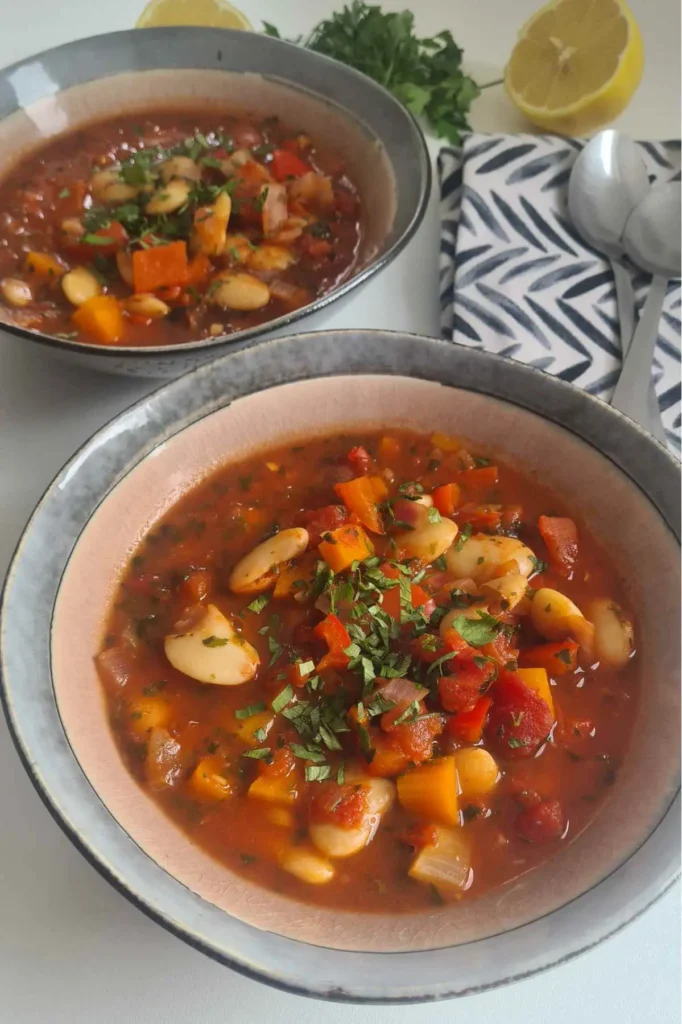Choosing low calorie high volume meals can be a great strategy if you want to feel full and satiated after eating, without consuming a lot of calories.
These types of meals are also low calorie density meals as they contain relatively few calories per volume of food. It’s easy to design an eating plan that reduces the number of calories consumed, but we don’t want to be hungry all of the time, and that is why choosing these types of meals can be a smart option. Since these meals are often contain lots of vegetables, it can also be the healthier option.
When we eat a meal, one of the mechanisms that helps us to feel full after the meal is the volume of food eaten. The volume of food is the space that it occupies. When the volume of food in the stomach has reached a certain amount, stretch receptors in the stomach lining are activated and is one of the mechanisms that helps to curb our appetite and tell us that we are full. Two things that contribute to the volume of food without adding any additional calories are water and fibre (or few calories in the case of fibre).
Water and Satiety
Low calorie high volume meals generally have a high water content, consisting of foods that have a high water content and also often have water or stock added to the recipe. Water increases the volume of the food without adding any additional calories. This helps to fill you up.
When the water is blended into the meal in the form of a soup for instance, it seems to have more of an effect on helping you feel full than simply drinking water with your meal. This is likely because water taken separately rather than blended into the meal is absorbed more quickly in the stomach, reducing its volume effect.
With that being said, studies have shown that water taken before a meal or during a meal, has resulted in less calories being consumed overall as part of the meal, so it seems that even water taken separately does have an effect on helping you to feel more full, while consuming less food overall.
Fibre and Satiety
Fibre is another food component that helps us to feel full. Fibre is a type of carbohydrate that our digestive enzymes cannot break down into simple sugar units for digestion, unlike starch which we can digest. We do actually get some calories from fibre as although we cannot break it, the bacteria contained in our colon can. Fibre absorbs water and takes up a lot of volume in our digestive tract.
4 High Volume Low Calorie Meal Options
- Soups
- Stews
- Salads
- Curries
Soups
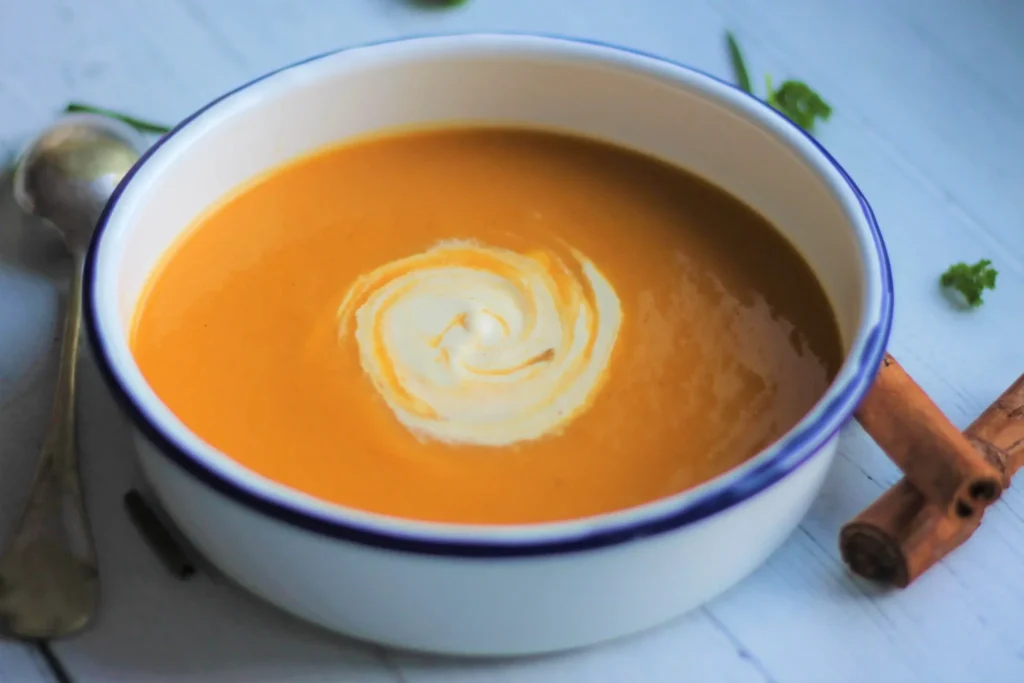
Many soups are high volume low calorie meals. This is because they are based around vegetables that are some of the lowest calorie dense foods we can eat. In addition to that, soups are usually made with a stock, and these tend to be very low in calories yet provide a lot of additional volume to the soup. Soups that contain starchy vegetables such as potatoes, sweet potatoes or carrots are still pretty low in calories overall as these vegetables are relatively low in calories.
Higher calorie soups are those that are creamier containing more added fats such as cream, butter or coconut milk.
The other thing that can make a soup much less of a low calorie high volume meal is to eat it with lots of bread, especially if the bread is buttered.
My Leek and Potato Soup and Easy Chickpea and Red Lentil Soup are two soup recipes that are low in calories and will help to fill you up.
Stews
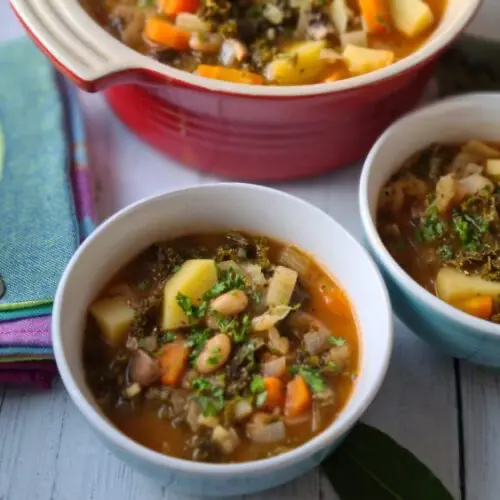
I am not exactly sure where the line between soups and stews exists exactly, however stews are essentially chunkier than soups. They often contain lots of chunky vegetables and a big bowl of stew with potatoes and other vegetables is usually quite light in calories. The calories can be increased significantly if the stew contains a lot of fatty meat such as fatty cuts or beef or lamb.
If you want to try a healthy stew recipe check out my Dutch Oven Vegetable Stew.
Salads

Salads are another great meal or starter to a meal that can help fill you up without containing a lot of calories. Although salads don’t usually have water added to them, they are based around vegetables and often green leaves, and these foods have a very high water content. Many vegetables are made up of 80 or 90% water. Eating a bit plate of veggies in the form of a salad is a a high volume meal that is low in calories.
Choose a low calorie salad dressing
One thing to watch out for with salads from a calorie point of view is the dressings. A lot of salad dressings are based around oil, and oil contains around 120 calories per tablespoon. A salad with a dressing that contains a few tablespoons of oil can easily double or triple the number of calories in the overall salad. Salad dressings based around various types of vinegar or citrus juices are much lower in calories. I have a post about low calorie salad dressings where you can find some options.
Curries
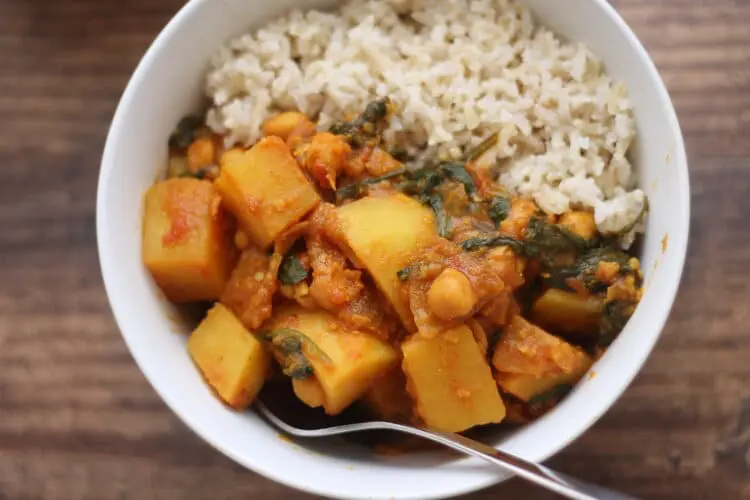
A curry can also be a low calorie high volume meal option. As with all of the other meal types, this depends on how the curry is made. For the creamier versions of curries that are made with high fat ingredients such as coconut milk, cream or butter, these are likely to be a lot higher in calories. A curry based around a tomato based sauce and simply flavoured with spices and containing added veggies is a much lower calorie option.
This low calorie spinach potato chickpea curry is a great option for a tasty tomato based curry. It comes in under 500 calories per portion with the rice making up over half the calories. In order to maintain the volume and decrease the overall calories, you can take a smaller portion of rice and add an extra scoop of curry.
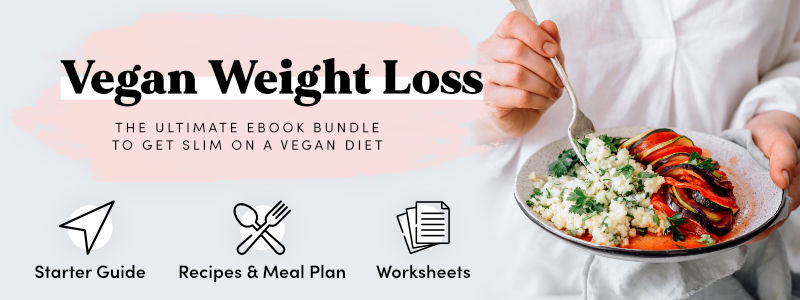
Related Topics to Low Calorie High Volume Meals
These types of meals can also be described as low calorie density meals. Calorie density is discussed further in my article on calorie density. You can also check out the calorie density chart I prepared showing the calorie density of popular food items. Preparing low calorie high volume meals involved choosing ingredients that are on the lower in calorie density.
I also wrote a similar LinkedIn article on High Volume Low Calorie Foods as a strategy for weight management.
